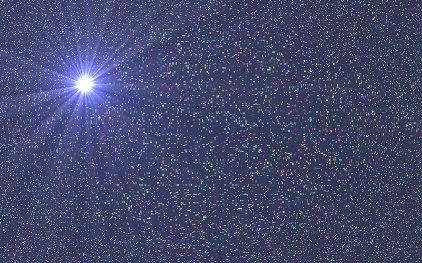Pulsars
If the Earth happens to lie in the beam of this cosmic lighthouse, we see it flash once each rotation. This is the reason it is called a pulsar. Blinking and ticking like a cosmic metronome, pulsars keep far better time than the most accurate ordinary clock. Long-term timing or the radio pulse rate of some pulsars, for instance, one called RSR 0329+54, suggests that these objects may have one or more small planetary companions. It is perhaps conceivable that a planet could survive the evolution of a star into a pulsar; or a planet could be captured at a later time. Astronomers wonder how the sky would look from the surface of such a planet.
Neutron star matter weighs about the same as an ordinary mountain per teaspoonful – so much that if you had a piece of it and let it go (you could hardly do otherwise), it might pass effortlessly through the Earth like a falling stone through air, carving a hole for itself completely through our planet and emerging out the other side – perhaps in China.
 |
| Pulsars. The Sun will end its days… And we, as a civilisation, as well. Image : Elena |
People there might be out for a stroll, minding their own business, when a tiny lump of neutron star plummets out of the ground, hovers for a moment, and then returns beneath the Earth, providing at least a diversion from the routine of the day.If a peace of neutron star matter were dropped from nearby space, with the Earth rotating beneath it as it fell, it would plunge repeatedly through, punching hundreds of thousands of holes before friction with the interior of our planet stopped the motion.
Before it comes to rest at the center of the Earth, the inside of our planet might look briefly like a Swiss cheese until the subterranean flow of rock and metal healed the wounds. It is just as well that large lumps of neutron star matter are unknown on Earth. But small lumps are everywhere. The awesome power of the neutron star is lurking in the nucleus of every atom, hidden in every teacup and dormouse, every breath of air, every apple pie. The neutron star teaches us respect for the commonplace.
A star like the Sun will end its days, as we know, as a red giant and then a white dwarf. A collapsing star twice as massive as the Sun will become a supernova and then a neutron star. But a massive star, left, after its supernova phase, with, say, five times the Sun’s mass, has an even more remarkable fate reserved for it – its gravity will turn it into a black hole.
No comments:
Post a Comment
You can leave you comment here. Thank you.